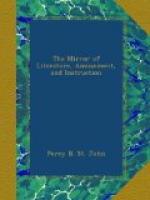the spring and summer. Here used to promenade,
for one or two hours after dinner, the whole British
world of gaiety, beauty, and splendour! Here
could be seen in one moving mass, extending the whole
length of the mall 10,000 of the most lovely women,
in this country of female beauty, all splendidly attired,
and accompanied by as many well-dressed men.
The present promenades in Hyde-Park lose the effect
produced by rank and distinguished character, owing
to those classes being shut up in their carriages.”
Another writer, speaking of the park in Charles’s
time, with its Dorimants, Millamours, and Millamants,
says, “every thing around breathes of beauty
and gaiety, the air is courtly, silks are rustling,
and feathers fluttering in the mall; fair forms are
hovering, and bright eyes glancing round; at every
turn you encounter lords and beauties.”
In the “neglected state” we have long
concurred; and we sympathize with our tourist in his
other lament; for the former we have a remedy at last,
and it affords us pleasure to know that the first
of these tourists possesses health and vigour to watch
the progress of the
improvements in the parks;
and we hope that he may live many years to enjoy their
completion. But for the second evil, we fear
there is no remedy, since the disease is mortal to
social happiness; unless that the proffered improvements
may once more reinstate the Montpellier promenades
of the park in fashion’s favour. Editors
are, however, very subordinate personages, when
——Fashion so directs,
and moderns raise
On fashion’s mould’ring base
their transient praise.
Be this as it may, we, who are so unfashionable
as to be occasional promenaders in the parks, rejoice
to present our readers with the annexed plan of the
improvements now in progress in St. James’s
Park, and in conjunction with the palace works they
denote the simultaneous study of the happiness of
the sovereign and the subject. Our country readers,
surrounded by all the blooming attributes of health,
will doubtless congratulate such important improvements
of what has been termed “the lungs of the metropolis.”
The annexed plan is reduced from the engraving which
accompanied the Treasury Minute, January 19, 1827;
from which the following are extracts:—
“The Earl of Liverpool and the
Chancellor of the Exchequer lay before the Board
a plan for building on the North and South sides of
St. James’s Park, (in addition to the buildings
already sanctioned upon the site of Carlton Gardens;)
and also for making some considerable alterations
in the distribution of the intermediate ground, whereby
the appearance of the park would be much improved,
while a very material accommodation would be afforded
to the public.
“They state, that they have received
the King’s commands to convey to the Board
his Majesty’s most gracious approbation of this
proposal, and his pleasure that the necessary




